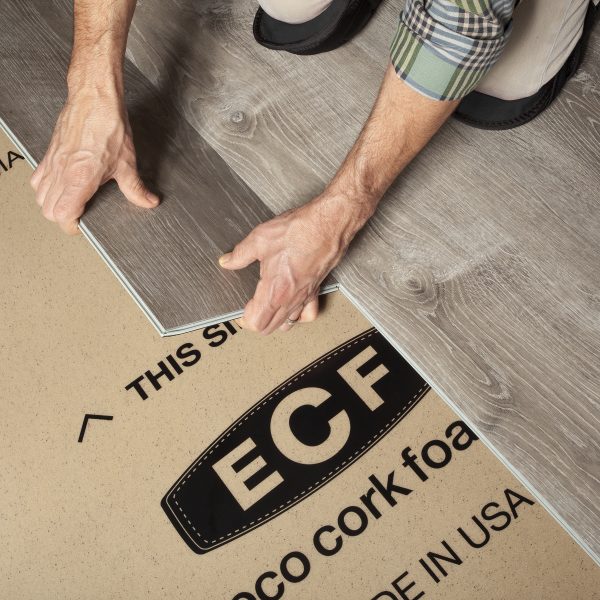If you’ve read much about Eco Cork Foam, you know that it’s ideal for use with today’s most popular flooring applications: vinyl (5mm or thicker), laminate, attached-pad laminate and engineered wood. If that vinyl caveat caught your eye, then pay attention. Today, we’re breaking down the different types of vinyl and explaining why that 5mm threshold exists.
When we refer to vinyl flooring, there are about four overall categories: peel-and-stick, sheet, tile and plank. But we can actually distill these even further into two classes of vinyl: standard and luxury.
Standard vinyl is what comes to mind when we think of traditional vinyl flooring. It’s sold in rolls, square tiles or planks, and constructed of a thin backing of felt or fiberglass bonded to a thin layer of vinyl. It includes a thin wear layer on top to protect the flooring from light damage. It’s inexpensive and easy to maintain and can last about 10-15 years. Standard vinyl tile is also very thin, averaging about 2-3mm in thickness. It’s installed by gluing the product directly to the floor or subfloor beneath it and because of this, underlayment cannot be used.
Luxury vinyl, on the other hand, is the vinyl you’re least likely to recognize. Whether planks or tiles, luxury vinyl is constructed more like laminate flooring, with several layers of material including a thicker wear layer and a sturdy rigid core. Like laminate, luxury vinyl uses a tongue-and-groove system to attach pieces together. Because of this robust construction, luxury vinyl is much thicker than standard vinyl. That thickness, coupled with the interlocking construction, allows the flooring to float in place, which allows space for underlayment. This thicker product, along with a protective underlayment, means luxury vinyl floors are not only a lot more comfortable, but also that they can last up to 25 years.
As we look at the differences in vinyl, we can see that thinner products rely on the surface below them for their stability. Products that are 5mm and thinner require either direct adhesion to the subfloor or a very thin underlayment. This makes for a good bargain but really limits the longevity and comfort of the floor. The more advanced, thicker products, especially when enhanced by a quality underlayment, construct a floor that is designed to look fabulous, feel great and last a long time.
About Us
ECF is manufactured in North Carolina by Palziv, North America. Palziv brings together world-class science and engineering to deliver innovative products, materials and services for the construction, building, automotive, recreational, medical and packaging industries. Every day, we strive to grow our community, working with others to seek sustainable, innovative, market-driven solutions that promote better, safer, and healthier lifestyles and protect the environment for generations to come.


